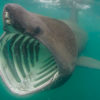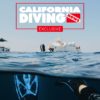During the course of the diving year in San Diego, I always look for new spots to dive. The La Jolla Peninsula offers up some incredible shore diving spots, but I am always drawn to spots that are out of the way and heavily trafficked. Ideally, I like spots that are not well known, have reefs that are not too beat up from divers, and offer a lot of marine life to look at. While just a stone’s throw away from some of the better-known La Jolla dive sites, Marine Street suits the criteria I look for in a new dive spot.
Marine Street (not to be confused with Marine Room to the North) is a beach shore dive filled with sandy flats and rocky reefs. To dive it, it requires only a beach entry directly off Marine Street.
Kelp fills in the area around some neat rocky reefs. This supports a variety of marine life and makes this a phenomenal dive. It is a really neat mix of marine life and creates a neat environment to swim in. You will normally see a mix of sand creatures and some fairly good-sized halibut. Several fish dart in and out of the rocks including calico bass, rockfish, sheepshead, garibaldis, treefish, and various pelagic fish. I have seen a lot of olive rockfish, rainbow surfperch, blacksmiths, cabezon, and halfmoons swimming around this spot.
Most of the dive area is sandy bottom interspersed with some reefs that attract marine life. You can make the dive as deep as you want depending on how far you want to swim. The dive generally starts in 10 feet of water and gets as deep as 50-60 feet if you swim out far enough.
LEOPARD SHARKS
I have always found Marine Street to be one of the premier spots to see Leopard Sharks in San Diego. Leopard sharks typically mate around April – May. They find Marine Street as an attractive area to mate in for some reason. The leopard shark is conspicuously covered with dark saddles and splotches. The leopard shark has a relatively broad and short snout.
Leopard sharks feed primarily on benthic invertebrates and small fish. Their diet includes invertebrates such as crabs, shrimp, and octopi. Leopard sharks are generally harmless to humans but, as always, be careful when approaching them.
HORSESHOE REEF
If you decide to swim out and to the north, there is an interesting reef named “Horseshoe Reef” that is a great dive. It gets its name due to the semi-circle rock reef shaped like a horseshoe. Horseshoe Reef is primarily a boat dive unless you want to do a “super swim” from the beach.
Marine Street is a well-known surf spot. Due to the locality of the spot, it is often crowded with surfers so it is best to dive only when there is no wave break. I have surfaced several times and nearly been run over by a long board, so you have to be careful. The locals get upset when you are ruining the “wave of the day” when you surface prematurely.
Dive Spot At A Glance
Location: Off La Jolla Peninsula, south of Casa Cove. Take La Jolla Blvd to Marine Street. Go west until you come to the beach.
Access: Beach dive for Marine Street. Boat or long swim for Horseshoe Reef.
Depths: 10-30 feet.
Skill Level: Beginner to Intermediate depending on conditions.
Visibility: Poor to good, averaging 10-15 feet.
Photography: God for macro. Lots of rockfish, halibut, and sand bass depending on the season. Great spot for seeing Leopard Sharks during May – April. Good amount of colorful small creatures, too.
Hunting: Average. Good amount of rockfish hunting. Good spot for halibut. Some lobster.
Hazards: Currents, surge, some boat traffic, and surfers.







